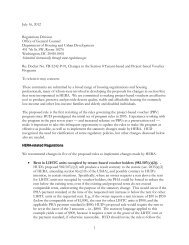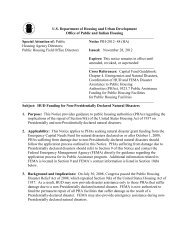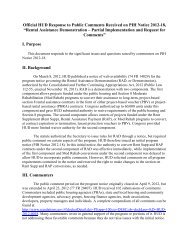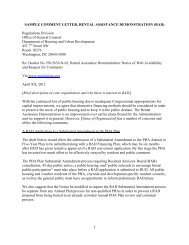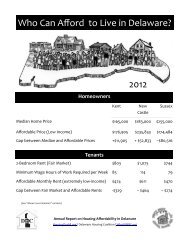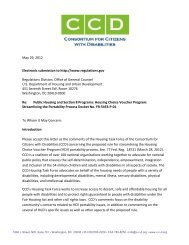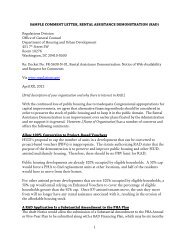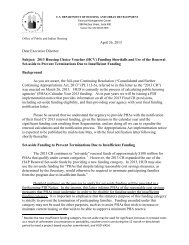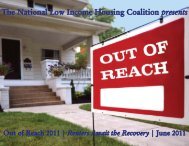Dark Before the Storm (.pdf, 131 KB) - National Low Income Housing ...
Dark Before the Storm (.pdf, 131 KB) - National Low Income Housing ...
Dark Before the Storm (.pdf, 131 KB) - National Low Income Housing ...
You also want an ePaper? Increase the reach of your titles
YUMPU automatically turns print PDFs into web optimized ePapers that Google loves.
Appendix 1: What are <strong>the</strong> CHAS Data?<br />
The Value of CHAS Data<br />
Comprehensive <strong>Housing</strong> Affordability Strategy (CHAS) data are available as special tabulations of <strong>the</strong> 1990 and 2000 Census<br />
and, most recently, of <strong>the</strong> 2005-2007 American Community Survey (ACS). These data are provided to HUD by <strong>the</strong> Census<br />
Bureau and provide users with an opportunity to analyze certain housing needs and housing affordability issues that cannot<br />
be gleaned from <strong>the</strong> standard Census and ACS data publicly provided by <strong>the</strong> Census Bureau. Specifically, <strong>the</strong>se data are<br />
based on HUD-defined income limits. These limits take into account HUD adjustments is determining <strong>the</strong> 30, 50 and 80%<br />
threshold of area median income (AMI)) and are for <strong>the</strong> appropriate HUD defined geography. These data allow planners,<br />
policy makers and researchers to better understand <strong>the</strong> housing needs of low income households identified in terms of<br />
<strong>the</strong> income categories used for HUD programs and research. These data are intended to be used by local governments<br />
throughout <strong>the</strong>ir Consolidated Planning process and HUD has used <strong>the</strong> data in allocation formulas for <strong>the</strong> distribution<br />
of funds to local jurisdictions. One program that is very likely to use CHAS data in its allocation formula is <strong>the</strong> <strong>National</strong><br />
<strong>Housing</strong> Trust Fund (NHTF), which will create and preserve affordable housing for those renters with <strong>the</strong> greatest need<br />
(Richardson, T. & Steffen, B., 2010).<br />
Comparing 2000 CHAS Data to 2005-2007 CHAS Data<br />
The ACS, <strong>the</strong> annual survey that has replaced <strong>the</strong> detailed survey or “long form” of <strong>the</strong> decennial census, was fully<br />
implemented in 2005. This survey allows more frequent updates on critical social, economic and housing data than was<br />
previously possible with <strong>the</strong> decennial census. Yet <strong>the</strong> conversion from <strong>the</strong> “long form” to <strong>the</strong> ACS creates some challenges<br />
for those who want to compare datasets. This is primarily due to <strong>the</strong> fact that <strong>the</strong> sample of households surveyed for <strong>the</strong><br />
ACS is much smaller than those of <strong>the</strong> decennial censuses, making <strong>the</strong> margin of error larger in <strong>the</strong> ACS. To overcome this<br />
problem, <strong>the</strong> Census has combined 3 years of ACS data to create <strong>the</strong> 2005-2007 ACS, providing larger sample sizes that<br />
allow users to examine smaller geographies.<br />
The o<strong>the</strong>r primary reason why CHAS data from <strong>the</strong> ACS are not directly comparable to CHAS data from <strong>the</strong> Census is that<br />
some questions from <strong>the</strong> 2000 survey changed wording or structure when asked in <strong>the</strong> ACS, <strong>the</strong>reby potentially changing <strong>the</strong><br />
understanding of <strong>the</strong> questions and <strong>the</strong> types of answers received. It is especially important to use caution when comparing<br />
<strong>the</strong> housing problems of those earning 51%-80% of AMI, because <strong>the</strong> methodology HUD used in 2005-2007 for determining<br />
80% of AMI differs from that used in 2000. In 2000, if 80% of an area’s median income was greater than <strong>the</strong> US median<br />
income, <strong>the</strong>n it would be capped at <strong>the</strong> US median income, as is done in HUD program implementation, but this adjustment<br />
was not made in <strong>the</strong> 2005-2007 CHAS data. This means that in some areas, it may look like <strong>the</strong>re was a large increase in<br />
<strong>the</strong> number of renters earning 50%-80% of AMI, but this increase may just be due to <strong>the</strong> omission of this adjustment in<br />
<strong>the</strong> data. Even with <strong>the</strong>se issues, it is possible to gain an understanding of <strong>the</strong> types of changes <strong>the</strong> country has seen in <strong>the</strong><br />
housing needs of low income renters in between surveys. In this report we make some comparisons between <strong>the</strong> 2000 and<br />
2005-2007 surveys, but we do so with <strong>the</strong> caveat that <strong>the</strong>se comparisons are to be used with caution.<br />
13



